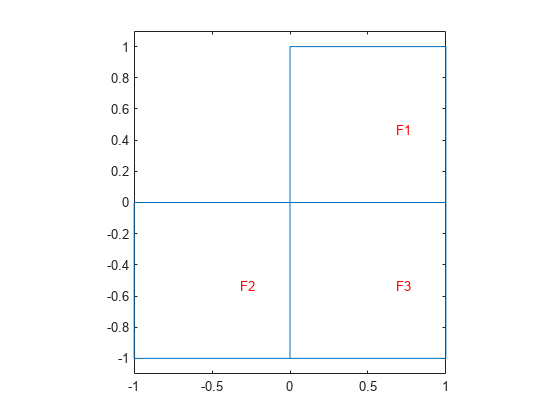View, Edit, and Delete Initial Conditions
View Initial Conditions
A PDE model stores initial conditions in its InitialConditions property. Suppose model is the name of your model. Obtain the initial conditions:
inits = model.InitialConditions;
To see the active initial conditions assignment for a region, call the findInitialConditions function. For example, create a model and view the geometry.
model = createpde(); geometryFromEdges(model,@lshapeg); pdegplot(model,FaceLabels="on") ylim([-1.1,1.1]) axis equal

Specify constant initial conditions over all the regions in the model.
setInitialConditions(model,2);
Specify a different initial condition on each subregion.
setInitialConditions(model,3,Face=2); setInitialConditions(model,4,Face=3);
View the initial condition assignment for region 2.
ics = model.InitialConditions; findInitialConditions(ics,Face=2)
ans =
GeometricInitialConditions with properties:
RegionType: 'face'
RegionID: 2
InitialValue: 3
InitialDerivative: []
This shows the "last assignment wins" characteristic.
View the initial conditions assignment for region 1.
findInitialConditions(ics,Face=1)
ans =
GeometricInitialConditions with properties:
RegionType: 'face'
RegionID: [1 2 3]
InitialValue: 2
InitialDerivative: []
The active initial conditions assignment for region 1 includes all three regions, though this assignment is no longer active for regions 2 and 3.
Delete Existing Initial Conditions
To delete all the initial conditions in your PDE model, use
delete. Suppose model is the name of your
model. Remove all initial conditions from model.
delete(model.InitialConditions)
To delete specific initial conditions assignments, delete them from the
model.InitialConditions.InitialConditionAssignments
vector.
icv = model.InitialConditions.InitialConditionAssignments; delete(icv(2))
Tip
You do not need to delete initial conditions; you can override them by calling
setInitialConditions again. However, deleting unused
assignments can make your model smaller.
Change an Initial Conditions Assignment
To change an initial conditions assignment, you need the initial conditions handle. To get the initial condition handle:
Retain the handle when using
setInitialConditions. For example,ics1 = setInitialConditions(model,2);
Obtain the handle using
findInitialConditions. For example,ics = model.InitialConditions; ics1 = findInitialConditions(ics,Face=2);
You can change any property of the initial conditions handle. For example,
ics1.RegionID = [1,3]; ics1.InitialValue = 2; ics1.InitialDerivative = @ut0fun;
Note
Editing an existing assignment in this way does not change its priority. For
example, if the active initial conditions in region 3 was
assigned after ics1, then editing ics1 to
include region 3 does not make ics1 the active
initial condition in region 3.